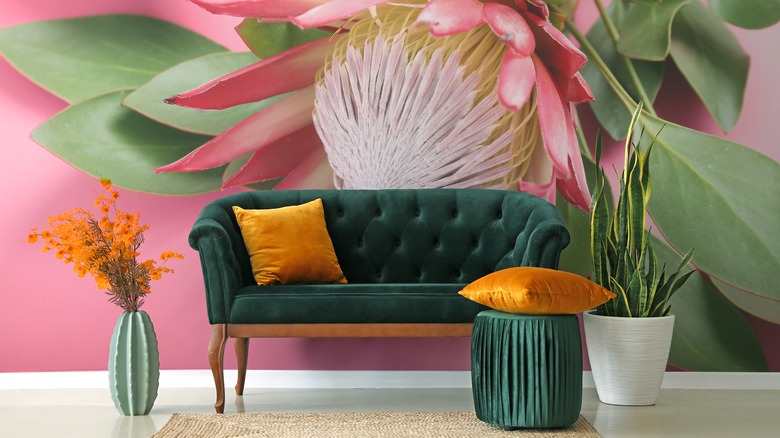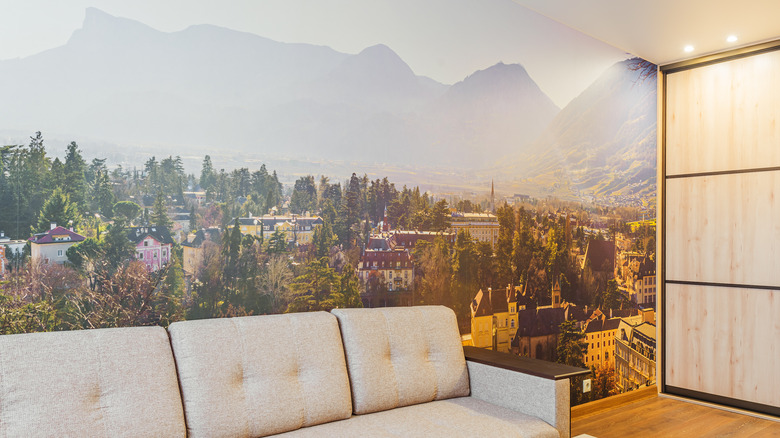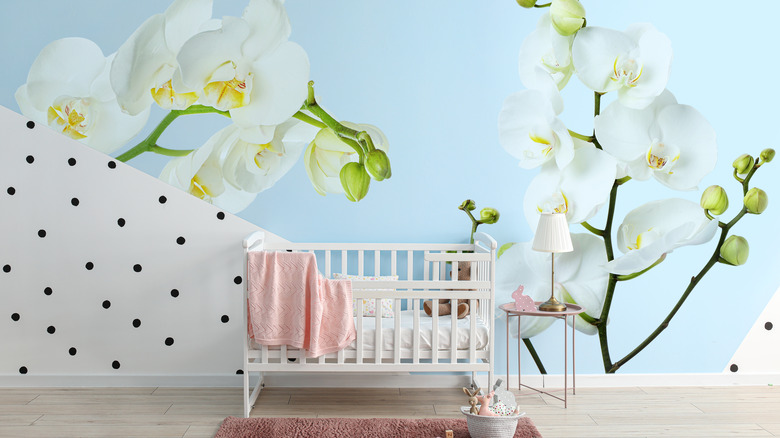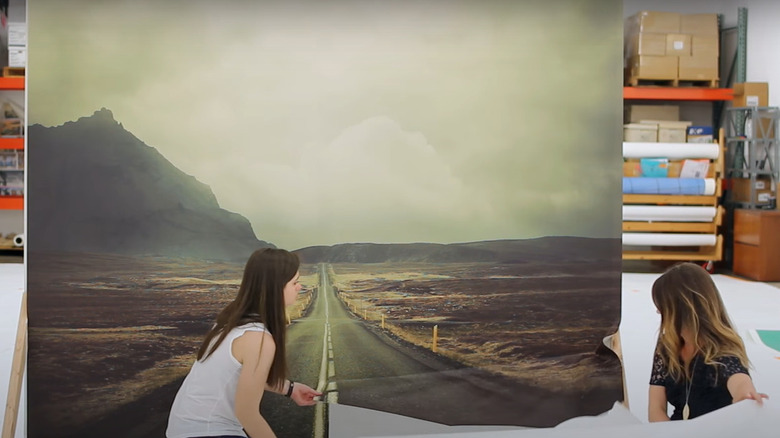Unique Wall Murals Are Taking Over Wallpaper
Want your favorite image to appear on a grander scale? Abstract or realistic, wall art murals are presently becoming a popular choice for decorating walls compared to wallpaper. Wall murals date back to about 30,000 B.C. in France's Chauvet Cave, which contains some of the finest examples of prehistoric cave paintings worldwide, per Mural Form. Wallpaper, meanwhile, especially hand-painted wallpaper, has origins dating back to ancient China, which often expressed natural scenes through floral, bird, or landscape designs. Today, celebrities like Gwyneth Paltrow (via Architectural Digest) and Kate Hudson (via Homes & Gardens) have chosen similar scenes within their own homes through high-end designers like MJ Atelier and Morris & Co.
While both murals and wallpaper have classic roots, wall murals may have supremacy over applying wallpaper. According to Chris loves Julia, wall murals are less restricting when it comes to the duplicated and repetitive patterns of wallpaper. Along with one large congruent image, the possibility of themes is endless; although, murals may reach their best potential when limited to a singular space. They also offer the freedom to customize an image however you choose.
Genuine wall murals may come in various styles of expression like damask and geometric patterns, including retro, scenic, and tropical designs. Places you might display a wall mural include foyers, hallways, bedrooms/children's rooms, and game rooms. Keep reading to learn about how to apply your own wall mural!
Various types of wall murals
With the endless options of images to explore with your wall mural, there are a few main types to consider: painted images and/or scenery, photography, or abstract. Generally, you can paint on walls or plaster in tempera, oil, or acrylic. Known for its quick-drying capabilities, acrylic paint often works best on most surfaces, including floors and walls, per Nova Color.
From a custom landscape to whimsical floral designs, your built-in artwork doesn't have to be limited to only being hand-painted. Photography murals can also be applied using your own high-quality image (like a family photo) or another art source. Photo wall murals might come in aluminum, canvas, photo board material, or vinyl while either being pasted to the wall like wallpaper or using a peel-and-stick (self-adhesive) method. Vinyl stickers are affordable and easy to apply to either small or big areas. A good way to apply a large mural, like a landscape or art print, is one that comes in several sectional panels.
Another mural medium that could be used in the kitchen or bathroom is a tile-based picture. Like the inventive Romans, tile creations often consist of unique mosaic designs or even hand-painted pieces that join to create a scene, per Love to Know. Other textures might include brick, metal, stone, or stained glass.
The best places to display a wall mural
Whether you want to add drama, romance, serenity, or fun, a wall mural makes a statement. The theme and approach of an authentic mural are entirely up to you. Lovely garden and nature scenes with various birds, flowers, trees, and branches may complement hallways, dining areas, bedrooms, and bathrooms. According to House Beautiful, you might recreate an iconic image from one of your favorite artists, or maybe a replica of an 18th-century style painting. Kids' rooms also provide boundless creative opportunities, from imaginative castles and clouds to colorful graffiti motifs. Additionally, an abstract mural might become a fascinating conversational piece while featured on a large-scale wall in your living room.
If you're going to paint or apply adhesive images within your mural, most surfaces will do if the texture is plain and minimal. Among drywall, glass, laminate, plastic, tile, and wood, you want a clean, smooth surface that fosters an even, seamless quality throughout. With plaster, you might level it using an orbital sander then install a paper wall liner for extra protection, explains Murals Your Way. Scraping and sanding will work best if the drywall layer has not been painted before. If your wall still isn't the right consistency, you might want to apply a skim coat (i.e., a thin layer of drywall).
How to create a one-of-a-kind wall mural
An important aspect of establishing a wall mural in your home is deciding whether you're going the DIY route or will hire a professional artist. Creating a masterpiece on your own may be rewarding and more cost-effective; although, a professional can get the job done efficiently in a matter of time. Many artists and muralists often display their social media accounts in the corners of their work and can be personally contacted via places like Instagram. According to Fixr, mural painting project costs typically range from $4,000 to $6,000, depending on the size and complexity. On average, homeowners can spend about $4,800 on a hand-painted piece, which covers 200 square feet. Moreover, while lower-cost projects may start at around $2,000, higher-end projects could reach $26,000 or more.
If you're thinking of painting a mural yourself, consider tools like mural paint, primer, brushes/sponges, painter's tape, and anything else required for your specific project. Start with a clean, blank surface and keep your sketch or plan nearby to reference throughout the process. According to Blushed Design, you can add a little water to keep the paint from thickening.
With peel-and-stick pieces (shown above via Murals Your Way), place the panels in order and accurately measure the wall space required before installation. Peel down the backing from the top corner, stick it onto the wall, then continue in a downward direction. Smooth out any bubbles or crinkles either by hand or with a smoothing tool as you match up each additional section.



